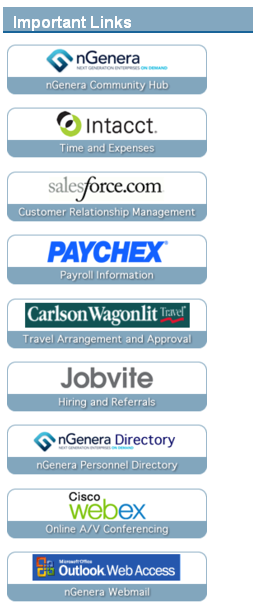 I try carefully not to post too much about nGenera on this blog, as its focus is centered more generically on trends in Enterprise 2.0. It occurred to me as we’re pulling together the Office 2.0 agenda, that the nGenera story is one which hopeful SaaS enthusiasts can look to for guidance and real world benchmarking.
I try carefully not to post too much about nGenera on this blog, as its focus is centered more generically on trends in Enterprise 2.0. It occurred to me as we’re pulling together the Office 2.0 agenda, that the nGenera story is one which hopeful SaaS enthusiasts can look to for guidance and real world benchmarking.
nGenera is 100% SaaS. The company was designed to deliver on the promise of “on demand” computing. With well over 300 employees now on three continents, we manage all our operations on a SaaS basis. The image to the left sits on our internal collaboration hub where all employees have one-click access to all the SaaS applications that run our company. Intacct, in fact, just issued a press release featuring our use of its Intacct Plus offering. We also use SaaS apps for collaboration, all our talent management (hiring, compensation, payroll, learning) and research projects.
We’ve done a good job integrating Salesforce.com, Intacct, and Open Air so our execs can make “on demand” decisions will real data. After only a year or so, with a run-rate close to $100M and profitability on the horizon*, we’re probably one of the better case studies out there for SaaS-as-a-Successstory.
So while some may declare the SaaS model bankrupt, as Lawson’s CEO recently did in this interview, we’ll continue to run our business on demand, and offer SaaS-based solutions to our customers. Our CEO is somewhat passionate on this topic and spoke recently at the AlwaysOn Summit at Stanford. You can watch the video here.
*“But nGenera has made a great deal of progress in a short period of time, has a great customer base to leverage and grow, and top notch senior management and investors to guide it. We believe that the company’s journey thus far has netted it a revenue run-rate approaching $100 million and could be cash flow positive by year end as the Talisma integration is completed.” (source: JMK Securities, July 2008.)

